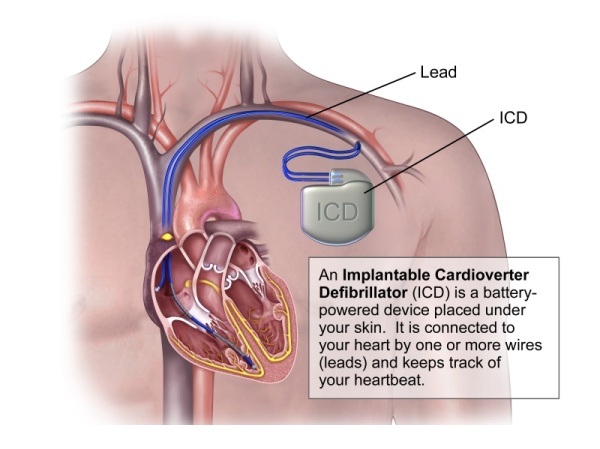An implantable cardiac defibrillator (ICD) is a cardiac device that is almost parallel to the size and shape of a pacemaker. The main function of an ICD is to revive you from tachyarrhythmias such as Ventricular Tachycardia (VT) or Ventricular Fibrillation (VF) which can lead to sudden cardiac arrest. VT or VF causes the heart to cease blood pumping affecting the blood circulation in your body and vital organs. The ICD’s main task is to immediately generate shock impulses called Anti-Tachycardia Pacing (ATP) to eradicate VT or VF and reset it back to its regular rhythm, if still unsuccessful, it continues to generate even larger shocks called Direct Current Cardioversion (DCCV). Some ICDs are able to act like a Pacemaker and pace the rhythm of the heart.

Iridia Medical. (2020). Retrieved from http://blog.iridiamedical.com/2012/05/24/cardiac-re-synchronization-therapy/
Procedure:
Implantable Cardiac Defribillator requires a minor surgical procedure to implant a device in your chest. The procedure typically takes a few hour and performed under local or general anaesthesia, antibiotics are usually given after to reduce the risk of infection. A small cut is made in your upper chest and insert insulated wires (leads, or electrodes) into a major vein under or near your collarbone and guided to your heart with the help of X-ray images.One end of each wire is secured to the appropriate position in your heart, while the other end is attached to a pulse generator, which is usually implanted under the skin beneath your collarbone. The surgeon will then test if the ICD is working correctly, then close the incision through a few stitches.
Sub-Cutaneous ICD (S-ICD)
S-ICDs are very similar to the traditional ICDs, they are also implanted on patients who are at a higher risk of getting tachyarrhythmias. These ICDs do not generate ATP shocks and pacing, so it is not suitable for patients who needs pacing for bradyarrhythmias. S-ICDs differs from the traditional ICDs as it is implanted under a layer of subcutaneous skin, in which its leads and electrodes sits beside the sternum above the heart.